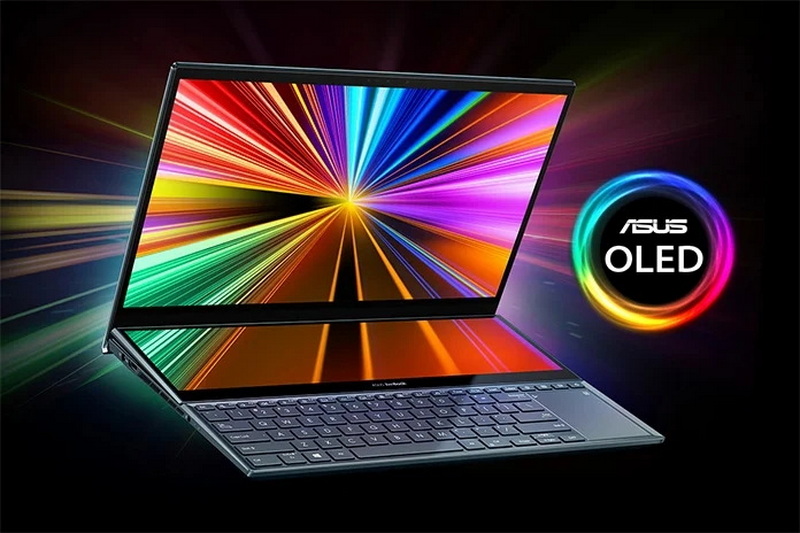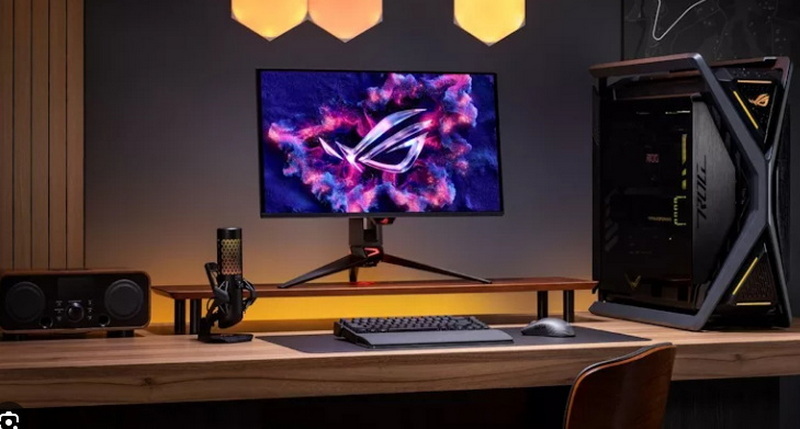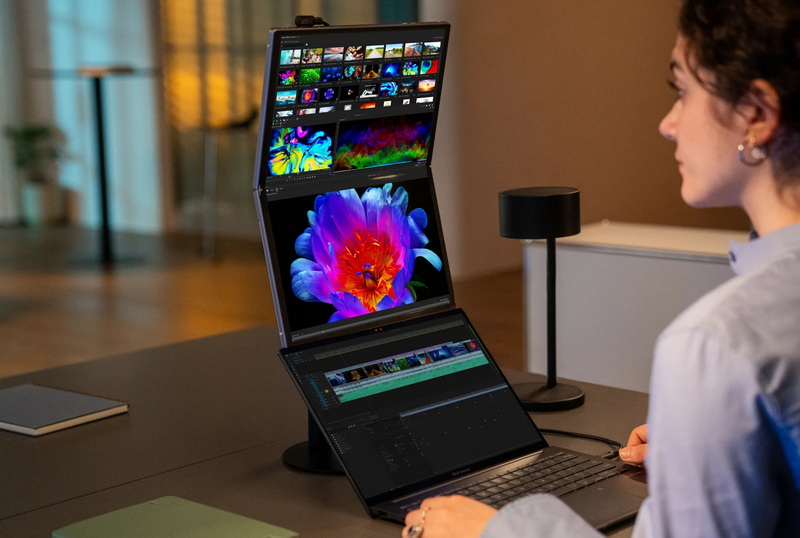








Content Menu
● Understanding ASUS OLED Screens
>> Advantages of ASUS OLED Screens
● Setting Up Your ASUS OLED Screen
>> Connecting to Multiple Devices
● Optimizing Visual Settings for ASUS OLED
>> Brightness and Contrast Adjustment
>> Refresh Rate and Resolution
● Using ASUS OLED Care Features to Protect Your Screen
>> Key Features of ASUS OLED Care
>> How ASUS OLED Care Extends Screen Life
● Advanced Usage Tips for ASUS OLED Screens
>> Productivity and Multimedia
● Maintenance and Troubleshooting
>> Firmware and Driver Updates
>> Troubleshooting Common Issues
● Frequently Asked Questions (FAQs)
>> 1. How do I enable ASUS OLED Care features on my monitor?
>> 2. Can I use my ASUS OLED screen for gaming without worrying about burn-in?
>> 3. How often should I perform pixel cleaning on my ASUS OLED monitor?
>> 4. What is the best display mode for reading on an ASUS OLED laptop?
>> 5. How do I update the firmware or drivers for my ASUS OLED device?
ASUS OLED screens represent a pinnacle of display technology, offering stunning visuals with deep blacks, vibrant colors, and fast response times. Whether you own an ASUS OLED laptop, monitor, or portable display, understanding how to use and care for your OLED screen is essential to maximize its lifespan and enjoy the best viewing experience. This guide covers everything from basic setup and usage tips to advanced features and maintenance techniques, complete with detailed explanations to enhance your understanding.

OLED (Organic Light Emitting Diode) technology differs fundamentally from traditional LCDs by using organic compounds that emit light when electrically stimulated. This allows each pixel to be individually lit or turned off, resulting in perfect blacks, higher contrast ratios, and more vivid colors. ASUS integrates OLED technology in various products, including gaming monitors, laptops, and portable screens, delivering superior image quality and responsiveness.
- True Blacks and Infinite Contrast: Because OLED pixels emit their own light and can be turned off completely, blacks appear truly black rather than dark gray.
- Vibrant and Accurate Colors: OLED displays cover wide color gamuts such as DCI-P3, making them ideal for creative professionals.
- Fast Response Time: OLED pixels switch on and off faster than LCD pixels, reducing motion blur in fast-moving images.
- Wide Viewing Angles: Colors and brightness remain consistent even when viewed from sharp angles.
- Energy Efficiency: When displaying darker content, OLED screens consume less power since pixels are off.
1. Unboxing and Connecting
Carefully unpack your ASUS OLED device and connect it to your computer or power source using the provided cables. For monitors, use DisplayPort or HDMI cables to connect to your PC's graphics card. Laptops and portable OLED screens commonly use USB-C connections that also deliver power.
2. Power On and Basic Configuration
Turn on your device using the power button. Access the On-Screen Display (OSD) menu by pressing the designated button on your monitor or using your laptop's display settings. Navigate through brightness, contrast, and color presets to adjust the display to your preference.
3. Selecting Display Modes
ASUS OLED screens often come with multiple preset modes such as Standard, sRGB, Game Mode, Theater Mode, and Reading Mode. Choose the mode that best suits your activity for optimal color accuracy and eye comfort.
Many ASUS OLED monitors support multiple input sources. Use the OSD menu to switch between HDMI, DisplayPort, or USB-C inputs based on your connected devices. This flexibility allows seamless switching between gaming consoles, PCs, and laptops without unplugging cables.
Adjust brightness to a comfortable level to avoid eye strain and reduce the risk of burn-in. OLED screens can achieve high brightness but prolonged exposure to maximum brightness can accelerate wear. It is recommended to keep brightness between 40% and 70% for daily use.
Contrast should be set to highlight details without washing out the image. ASUS presets typically optimize contrast, but manual tweaking can help if you prefer a specific look.
For professional use such as photo editing or video production, accurate color representation is critical. Use built-in color calibration tools or external calibration devices to ensure color accuracy. ASUS monitors often include a Color Calibration Report feature to verify color fidelity.
Set your monitor to its native resolution (commonly 1440p or 4K) and the highest supported refresh rate (up to 240Hz on some models) for smooth visuals, especially important for gaming and video playback. Higher refresh rates reduce motion blur and input lag.

ASUS OLED Care is a suite of built-in features designed to protect your OLED screen from burn-in and extend its lifespan. These features are accessible via the ASUS OSD menu or dedicated software.
- Screen Dimming Control: Automatically dims the screen when no movement is detected, restoring brightness upon activity.
- Adjust Logo Brightness: Detects static logos and reduces their brightness to prevent image retention.
- Taskbar and Boundary Detection: Lowers brightness around static UI elements like taskbars and black bars.
- Outer and Global Dimming Controls: Dynamically adjust brightness of bright areas and overall screen brightness.
- Uniform Brightness: Maintains consistent brightness levels across windows and screen areas.
- Target Mode: Keeps only the active window bright, dimming the rest of the screen.
These features are enabled by default and recommended to remain on to maintain warranty coverage and screen health.
By actively managing brightness and dimming static image areas, ASUS OLED Care reduces the risk of permanent image retention, a common concern for OLED displays. This proactive approach helps maintain vibrant colors and sharp contrast over years of use.
- Use GamePlus and GameVisual hotkeys to quickly switch between gaming presets tailored for different genres.
- Enable high refresh rates and low latency settings for competitive gaming.
- Use pixel cleaning functions regularly to maintain image quality and prevent ghosting.
- Take advantage of HDR support for richer colors and deeper contrast in supported games.
- Use Reading Mode or Darkroom Mode for prolonged reading or low-light environments to reduce eye strain.
- Enable HDR for supported content to enjoy enhanced dynamic range and color depth.
- Utilize USB-C charging and connectivity features for portable OLED screens to reduce cable clutter.
- Customize color profiles for different tasks such as photo editing, video streaming, or office work.
If using multiple ASUS OLED monitors, calibrate each screen individually to ensure consistent color and brightness across displays. Use software tools to manage window placement and optimize workflow.
ASUS OLED monitors include a Pixel Cleaning feature that recalibrates pixels to prevent image retention. This process runs automatically when the monitor is turned off but can also be manually activated through the OSD menu.
- Avoid displaying static images or UI elements for extended periods.
- Use screen savers and automatic dimming features.
- Regularly shift screen content slightly using Screen Move settings to prevent pixel overuse in one area.
- Reduce maximum brightness and use dark mode themes where possible.
Keep your ASUS OLED device firmware and graphics drivers up to date to benefit from the latest optimizations and fixes. Check ASUS's official support website regularly for updates.
- Screen Flickering: Check cable connections and update drivers.
- Color Inaccuracy: Recalibrate the display using built-in tools or external calibrators.
- Image Retention: Run pixel cleaning and enable OLED Care features.
ASUS OLED screens offer exceptional visual experiences with their deep blacks, vibrant colors, and fast response times. Proper setup, usage, and care are crucial to maximize their lifespan and performance. Utilizing ASUS OLED Care features protects your screen from burn-in, while adjusting display settings ensures optimal viewing comfort and accuracy. Whether for gaming, professional work, or multimedia consumption, understanding how to use your ASUS OLED screen will enhance your overall experience and preserve the quality of your display for years to come.

Access the OSD menu via the monitor's control buttons, navigate to the ASUS OLED Care section, and ensure features like Screen Dimming Control, Logo Brightness Adjustment, and Boundary Detection are enabled. These are usually on by default.
Yes, but it's important to use ASUS OLED Care features and avoid static images for prolonged periods. Regular pixel cleaning and dynamic brightness adjustments help minimize burn-in risk.
Pixel cleaning runs automatically when the monitor powers down, but you can manually trigger it if you notice image retention. Doing this periodically, especially after long usage sessions, is recommended.
Reading Mode or Darkroom Mode reduces blue light and adjusts brightness to reduce eye strain, making these modes ideal for reading.
Visit the official ASUS support website, locate your model, and download the latest firmware and driver updates. Follow the provided instructions carefully for installation.
This comprehensive article answers the question "Can I Upgrade My E-Bike LCD Display Easily?" by exploring display types, compatibility, practical upgrade steps, troubleshooting, and maintenance tips. Boost your riding experience and get the most from your LCD display e-bike with the best current advice, illustrations, and video guidance.
This comprehensive guide explores the troubleshooting and repair of backpack LCD display issues, covering blank screens, flickers, garbled text, address conflicts, and more. It offers stepwise solutions and practical videos to help users swiftly restore functionality in their hardware projects.
Discover why the Sharp memory LCD display outperforms traditional LCDs with lower power use, unmatched sunlight readability, robust reliability, and a straightforward interface. Learn about its technology, applications, pros and cons, integration tips, and get answers to common engineering questions.
OLED displays, though admired for their visuals, may cause digital eye strain or "OLED screen eye tire" during extended use because of blue light, potential PWM flicker, and intense color/contrast. By using optimal settings and healthy habits, users can safely enjoy OLED with minimal discomfort.
Does displaying a white screen on an LG OLED TV fix persistent burn-in? The answer is no: true burn-in results from irreversible pixel wear and chemical aging. The best practice is to use preventive features, moderate settings, and varied content to safeguard screen health. For severe cases, panel replacement is the only cure.
An in-depth guide to the LCD display bezel: its definition, history, materials, structure, and growing role in display design. Explores bezel importance, types, aesthetic trends, maintenance, and innovation, offering expert insights—including an expanded FAQ and practical visuals—to help users understand its unique place in technology.
This article provides a complete, practical guide to diagnosing and fixing non-responsive SPI LCD displays using methods including hardware validation, logic level correction, library configuration, and advanced diagnostic tools. Perfect for hobbyists and engineers alike.
LCD display liquid coolers deliver top-tier performance with visually stunning customizable LCD panels that display system data and artwork. They suit enthusiasts and streamers aiming for unique builds but may be unnecessary for budget or basic systems. The price premium is justified by advanced hardware, software, and customization features.
Black bars on an OLED screen do not cause burn-in as those pixels are switched off. Only with excessive, repetitive content does minor uneven aging become possible. Varying viewing habits and enabling panel maintenance prevents problems in daily use.
OLED TVs provide spectacular picture quality but rely heavily on the quality of the video input. Most cable broadcasts are limited to lower resolutions and compressed formats, so an OLED screen connected to a regular cable box will look better than older TVs but may not realize its full potential. Upgrading cable boxes and utilizing streaming services can unlock the best OLED experience.
OLED screen burn-in remains one of the key challenges inherent in this display technology. While no universal fix exists for permanent burn-in, a blend of app-based tools, manufacturer features, and maintenance practices can help reduce appearance and delay onset. Proper prevention strategies and use of built-in pixel shift and refresher tools offer the best chances of avoiding this issue.
This article comprehensively explores will OLED screen burn in over time by explaining the science of OLED displays, causes and types of burn in, manufacturer solutions, prevention tips, and real-world user experiences. Burn in risk does exist, but modern panels and user habits greatly reduce its likelihood, making OLED an excellent and long-lasting display choice.
This article provides an in-depth guide to selecting the best LCD display driver IC for various applications, covering driver types, key features, leading manufacturers, integration tips, and practical examples. It includes diagrams and videos to help engineers and hobbyists make informed decisions about LCD display driver selection.
Dead pixels are a common type of LCD display defect, caused by manufacturing faults, physical damage, or environmental factors. While stuck pixels may be fixable, dead pixels are usually permanent. Proper care and understanding can help prevent and address these issues.
This comprehensive guide explains every symbol and function found on e-bike LCD displays, using clear explanations and practical tips. Learn to interpret battery, speed, PAS, error codes, and customize settings using your e-bike LCD display manual for a safer, smarter ride.
This comprehensive guide explains how to set an LCD display clock, covering everything from hardware setup and wiring to coding, troubleshooting, and creative customization. With detailed instructions and practical tips, you'll learn to confidently build and personalize your own LCD display clock for any setting.
This article explores whether OLED laptop screens are prone to burn-in, examining the science, real-world evidence, prevention methods, and lifespan. It provides practical advice and answers common questions to help users make informed decisions about OLED technology.
Displaying a black screen on an OLED TV will not cause burn-in, as the pixels are turned off and not subject to wear. Burn-in is caused by static, bright images over time. With proper care and built-in features, OLED TVs are reliable and offer exceptional picture quality.
This article explores the causes of OLED screen burn-in, the science behind it, and effective prevention strategies. It covers signs, effects, and potential fixes, with practical tips to prolong your OLED display's lifespan and answers to common questions about burn-in.
OLED screens deliver unmatched image quality, with perfect blacks, vivid colors, and ultra-fast response times. Despite higher costs and some risk of burn-in, their advantages make them the top choice for premium displays in TVs, smartphones, and monitors.